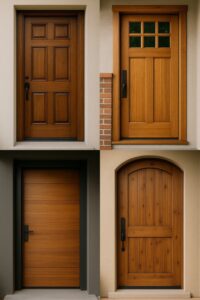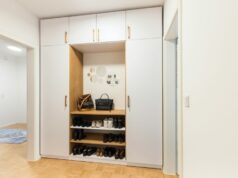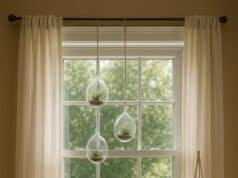Table of Contents
- Why Material Matters When Selecting a Front Door
- Popular Wood Door Styles and Their Appeal
- Designing with Light: Glass Panels and Windows in Wood Doors
- Finding the Right Color and Finish for Your Entryway
- Modern vs. Traditional: Which Fits Your Home?
- Energy Efficiency Considerations for Wooden Doors
- Installation and Maintenance Tips for Long-Lasting Beauty
- Frequently Asked Questions About Wood Door Selection
- Further Reading & Resources
Why Material Matters When Selecting a Front Door
The material you choose for your front door forms the foundation of your home’s appearance, functionality, and value. Wood has been a go-to choice for generations, and not just for its beauty—its density provides natural insulation, its heft deters unwanted entry, and its versatility means you can find a wooden door to suit any style. When browsing options in person or deciding where to buy front doors online, it’s essential to remember how wood interacts with your local climate and how lifestyle needs play into performance.

Depending on the species and construction method, wood doors can handle humid environments, direct sunlight, and even heavy rain, if properly sealed and maintained. Some types, like mahogany and teak, are naturally resistant to rot and pests, making them smart long-term investments for homeowners looking for a durable and attractive entry solution. Today’s wood doors are reinforced by modern technology. They can be paired with advanced locking systems to ensure peace of mind on every front porch.
Popular Wood Door Styles and Their Appeal
Personal style is often the most exciting part of choosing a wood door, and countless possibilities exist. A panel door is an archetype—its symmetrical design and raised sections make it suitable for stately traditional homes and updated contemporary properties. Craftsman doors stand out with their geometric shapes, mission-style glass panes, and solid construction, lending a welcoming, artistic touch to bungalows and cottages alike.
Modern tastes have brought slab doors back into the spotlight. With their flat surfaces and lack of ornamentation, these doors excel in minimalist and mid-century-inspired homes. If you’re drawn to rustic aesthetics, a plank-style wood door—think vertical boards with visible knots and natural textures—adds charm and coziness reminiscent of countryside estates or vintage farmhouses. Whatever you choose, hardware and finishing touches such as contemporary handles, period-inspired knockers, or oversized hinges can dramatically elevate the look.
Designing with Light: Glass Panels and Windows in Wood Doors
Incorporating glass into a wood door is both practical and artistic. Full-light or half-light glass panels are increasingly popular because they amplify natural light, making interiors more expansive and inviting. Even a small eye-level window can brighten your foyer and add visual interest to your entryway.
Homeowners concerned with privacy and security have plenty of attractive options. Frosted, obscured, or stained glass inserts let in sunlight without making your home a display for passersby. Creative use of sidelights (narrow windows flanking the door) or a transom (window above the door) can enhance the sense of height and openness. Custom glass elements allow homeowners to integrate pops of color, etched designs, or personalized motifs that reflect family heritage and personal taste.
Finding the Right Color and Finish for Your Entryway
The aesthetic impact of your front door is deeply influenced by its color and finish. Rich stains—like chestnut, cherry, or espresso—tend to showcase the grain and character of the wood. These finishes are prized for their ability to highlight the craftsmanship and luxury of hardwood construction, making a subtle but memorable statement. On the other hand, paint opens up an entire spectrum of possibilities, from eye-catching reds and blues to sophisticated neutrals like charcoal or sage.
Picking the right finish is not just about looks—it also helps preserve the door’s longevity. A top coat of clear sealer guards against moisture, while UV-resistant finishes defend against fading and cracking in sunny climates. Some doors come pre-finished for convenience, but applying a custom stain or paint is a popular weekend project for homeowners who want to add a personalized touch to their exterior. Harmonizing your front door color with siding, trim, and outdoor landscaping is a great way to elevate the entire home’s curb appeal.
Modern vs. Traditional: Which Fits Your Home?
Many homeowners wonder whether to choose a traditional or modern wood door style. Traditional homes, with their gabled rooflines or classic columns, often pair well with ornate panel doors, arched tops, or old-world hardware like antique brass knockers. These features reinforce a sense of history and belonging.
For homes with minimalist landscaping, flat roofs, or expanses of glass, a modern door with simple lines, smooth surfaces, and a single vertical or horizontal glass insert may be the optimal choice. However, blending these elements can create dynamic contrast—a classic paneled wood door paired with modern, matte black hardware or a rustic plank door featuring a sleek frosted-glass panel. This kind of fusion nods to both past and present, ensuring the front of your home feels fresh and timeless.
Energy Efficiency Considerations for Wooden Doors
Entry doors are a crucial barrier against heat, cold, wind, and rain. While solid wood is excellent at insulating, maximizing energy efficiency also involves the door’s installation, fit, and additional features. Well-fitted weatherstripping and thresholds prevent drafts or leaks, especially when seasons change dramatically.
Even the best door can underperform if it’s improperly installed or lacks sufficient sealing. According to energy studies, homes lose a surprising amount of heating and cooling—up to 30%—through poorly fitted doors and windows. If you want extra insurance against energy loss, look for wooden doors with an insulated core or energy-rated glazing for glass inserts. These steps lower monthly bills, contribute to indoor comfort, and support sustainable living.
Installation and Maintenance Tips for Long-Lasting Beauty
How your wood door is installed significantly affects its performance. A secure, level installation keeps the door from sticking, gapping, or wearing unevenly over time. It’s best to ensure skilled hands handle the process or to follow the manufacturer’s instructions meticulously if you’re tackling it yourself.
Regular care is just as crucial for longevity. Wipe away dust and dirt with a soft, damp cloth every few weeks. Inspect finishes at least once a year; address any chips or cracks proactively to prevent water from entering the wood. Reapplying protective sealant or paint every few years is well worth the effort. Lubricate hinges and locks as needed for smooth operation, and don’t overlook weatherstripping—swap it out whenever it begins to crack or peel. Such routine attention keeps your home’s primary portal looking impressive for decades.
Frequently Asked Questions About Wood Door Selection
- Do wood doors warp over time? Wood is a natural material, meaning it responds to humidity and temperature. However, modern treatments, engineered cores, and high-quality finishes have dramatically reduced the risk of warping in today’s wood doors. Keeping the door protected from excess moisture and refinishing it when needed will safeguard its form and function.
- How much upkeep does a wood door require? With quality construction and finishing, most wood doors need annual cleaning and spot resealing or repainting every few years. Doors exposed to direct weather may need more frequent attention, making preventive care the key to a lasting investment.
- Are wooden doors a secure option? Yes. When made from solid hardwood or engineered wood cores and fitted with quality locks and reinforced jambs, wooden entry doors are highly secure and hold up well to time and the elements.








